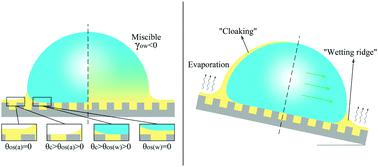当前位置:
X-MOL 学术
›
Mater. Horiz.
›
论文详情
Our official English website, www.x-mol.net, welcomes your
feedback! (Note: you will need to create a separate account there.)
What are the design principles, from the choice of lubricants and structures to the preparation method, for a stable slippery lubricant-infused porous surface?
Materials Horizons ( IF 12.2 ) Pub Date : 2020-02-28 , DOI: 10.1039/d0mh00088d Xiangsheng Chen 1, 2, 3, 4, 5 , Gang Wen 1, 2, 3, 4, 5 , Zhiguang Guo 1, 2, 3, 4, 5
Materials Horizons ( IF 12.2 ) Pub Date : 2020-02-28 , DOI: 10.1039/d0mh00088d Xiangsheng Chen 1, 2, 3, 4, 5 , Gang Wen 1, 2, 3, 4, 5 , Zhiguang Guo 1, 2, 3, 4, 5
Affiliation

|
Despite decades of research, superhydrophobic surfaces still rely on a stable air layer that is plagued with problems, such as poor pressure stability, the inability to self-heal, and the failure to repel organic liquids or complex mixtures with low surface tension, and this seriously restricts their applicability. To address these limitations, new Nepenthes pitcher plant-inspired materials with a continuous liquid layer have been proposed, which are defined as slippery lubricant infused porous surfaces (SLIPS) that rely on a stable liquid layer. They show pressure stability, self-healing, and omniphobic properties with extremely low contact angle hysteresis for almost all liquids (such as blood, oil, and even butane, where γ ≈ 13 mN m−1). However, these surface functions will be diminished over time due to the depletion of the lubricant layer by various factors, including evaporation, solubility, shearing, the loss of the cloaking layer or the wetting ridge, etc. Therefore, it is critical to improve the stability of the lubricant layer for the preparation of stable and durable SLIPS. In this review, we mainly focus on how to enhance the stability of the lubricant layer and reduce the loss of lubricants to prolong the longevity of SLIPS. We start from the design principles, which should ensure that the substrate can be infiltrated and wetted by the lubricant rather than by external droplets. Thereafter, the effects of the physical properties of the lubricant (e.g. viscosity, vapor pressure, surface tension, etc.) and the type of structure (flat vs. rough, nanoscale vs. microscale vs. hierarchical, closed-cell vs. open-cell) on prolonging the lifetimes of SLIPS are discussed. Finally, a variety of physical and chemical methods have been explored, which aim to maintain a stable lubricant layer through capillary force, chemical interactions, swelling or by an embedded lubricant reservoir, as well as to maintain stimuli-responsive SLIPS that avoid unnecessary lubricant loss by employing microcapsules that lock up the lubricants or a phase changeable lubricant.
中文翻译:

从润滑剂和结构的选择到制备方法,设计稳定的光滑润滑剂注入的多孔表面有哪些设计原则?
尽管进行了数十年的研究,但超疏水性表面仍依赖稳定的空气层,该空气层受困于诸如压力稳定性差,无法自愈,无法排斥表面张力低的有机液体或复杂混合物等问题。严重限制了它们的适用性。为了解决这些限制,已经提出了具有连续液体层的新的猪笼草捕虫笼启发性材料,其被定义为依靠稳定的液体层的光滑润滑剂注入的多孔表面(SLIPS)。它们显示出压力稳定,自我修复,并具有极低接触角滞后omniphobic性质几乎所有液体(如血液,油,和甚至丁烷,其中γ听,说:13 MN米-1)。但是,由于各种因素(包括蒸发,溶解度,剪切,隐蔽层或润湿脊的损失等),润滑剂层的损耗会导致这些表面功能随着时间的推移而减弱。因此,至关重要的是改善稳定的润滑剂层,用于制备稳定耐用的SLIPS。在这篇综述中,我们主要集中于如何增强润滑剂层的稳定性和减少润滑剂的损失以延长SLIPS的使用寿命。我们从设计原理开始,该设计原理应确保基材可以被润滑剂而不是外部液滴渗透和润湿。此后,润滑剂的物理特性(例如粘度,蒸气压,表面张力,等等),并讨论了延长SLIPS寿命的结构类型(平面与粗糙,纳米与微米,分层,闭孔与开孔)。最后,已经探索了多种物理和化学方法,其目的是通过毛细作用力,化学相互作用,溶胀或通过嵌入的润滑剂容器来维持稳定的润滑剂层,以及维持刺激性SLIPS以避免不必要的润滑剂损失通过使用微囊来锁定润滑剂或相变润滑剂。
更新日期:2020-02-28
中文翻译:

从润滑剂和结构的选择到制备方法,设计稳定的光滑润滑剂注入的多孔表面有哪些设计原则?
尽管进行了数十年的研究,但超疏水性表面仍依赖稳定的空气层,该空气层受困于诸如压力稳定性差,无法自愈,无法排斥表面张力低的有机液体或复杂混合物等问题。严重限制了它们的适用性。为了解决这些限制,已经提出了具有连续液体层的新的猪笼草捕虫笼启发性材料,其被定义为依靠稳定的液体层的光滑润滑剂注入的多孔表面(SLIPS)。它们显示出压力稳定,自我修复,并具有极低接触角滞后omniphobic性质几乎所有液体(如血液,油,和甚至丁烷,其中γ听,说:13 MN米-1)。但是,由于各种因素(包括蒸发,溶解度,剪切,隐蔽层或润湿脊的损失等),润滑剂层的损耗会导致这些表面功能随着时间的推移而减弱。因此,至关重要的是改善稳定的润滑剂层,用于制备稳定耐用的SLIPS。在这篇综述中,我们主要集中于如何增强润滑剂层的稳定性和减少润滑剂的损失以延长SLIPS的使用寿命。我们从设计原理开始,该设计原理应确保基材可以被润滑剂而不是外部液滴渗透和润湿。此后,润滑剂的物理特性(例如粘度,蒸气压,表面张力,等等),并讨论了延长SLIPS寿命的结构类型(平面与粗糙,纳米与微米,分层,闭孔与开孔)。最后,已经探索了多种物理和化学方法,其目的是通过毛细作用力,化学相互作用,溶胀或通过嵌入的润滑剂容器来维持稳定的润滑剂层,以及维持刺激性SLIPS以避免不必要的润滑剂损失通过使用微囊来锁定润滑剂或相变润滑剂。











































 京公网安备 11010802027423号
京公网安备 11010802027423号